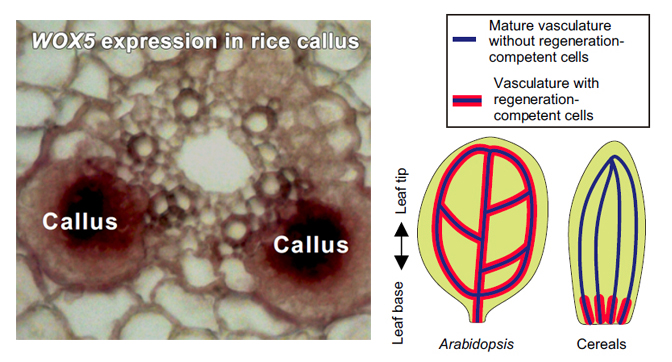
Tissue culture, based on the plant regenerative abilities, has been widely exploited in agricultural technology for more than half a century. Formation of a pluripotent cell mass from detached explant, known as callus, is the first step in tissue culture.
Callus can be produced by almost all organs of the typical dicot plant Arabidopsis during their whole life. However, the mature organs of monocot cereal species, such as rice, maize and wheat, demonstrate unresponsiveness to in vitro culture techniques, perplexing the agricultural applications of tissue culture in cereals for a long time.
Using the monocot cereals rice and maize together with the dicot model plant Arabidopsis, Dr. XU Lin and his colleagues at Shanghai Institute of Plant Physiology and Ecology of Chinese Academy of Sciences showed that the Arabidopsis and cereals use separate strategies in maintaining regeneration-competent cells during organ maturation, resulting in different regenerative abilities. The paper was published in Regeneration as a cover story.
The study on Arabidopsis conducted by scientists revealed that procambium and some vascular parenchyma cells in leaves and xylem-pole pericycle cells in roots serve as regeneration-competent cells to initiate callus. In contrast, for rice and maize, bundle sheath and some immature vascular cells in the immature region (about 2 mm at the bottom region) of young leaves and phloem-pole pericycle cells in roots may serve as regeneration-competent cells to produce callus.
Interestingly, they found that although Arabidopsis and cereals deploy different types of regeneration-competent cells, they all use the same molecular pathway (WOX11-WOX5) for callus initiation. Arabidopsis maintain the regeneration competent-cells during organ maturation, while cereals exhaust regeneration-competent cells during organ maturation and lose regenerative ability in mature organs. For example, the outer bundle sheath in the rice mature leaf differentiated into large parenchyma cells, and the bundle sheath differentiated into Kranz anatomy in maize mature leaves. Therefore, those differentiated cells lose the ability for regeneration.
This work was funded by National Natural Science Foundation of China, Ministry of Science and Technology of China, and Chinese Academy of Sciences.

Arabidopsis and cereals deploy different types of regeneration-competent cells, which all use the WOX11-WOX5 pathway for callus initiation. (Image by Dr. XU’s lab)

86-10-68597521 (day)
86-10-68597289 (night)

86-10-68511095 (day)
86-10-68512458 (night)

cas_en@cas.cn

52 Sanlihe Rd., Xicheng District,
Beijing, China (100864)

